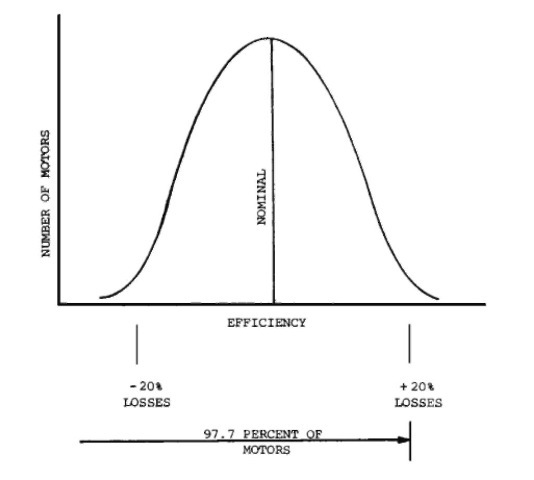2.6
Coincident with the NEMA test program,
it was determined that a more consistent and meaningful method of expressing electric motor efficiency was necessary. The method should recognize that motors, like any other product, are subject to variations in material, manufacturing processes, and testing that cause variations in efficiency on a motor-to-motor basis for a given design.
No two identical units will perform in exactly the same way.
Variance in the electrical steel used for laminations in the stator and rotor cores will cause variance in the magnetic core loss. Variance in the diameter and conductivity of the magnet wire used in the stator winding will change the stator winding resistance and hence the stator winding loss. Variances in the conductivity of aluminum and the quality of the rotor die casting will cause changes in the rotor power loss. Variances also occur in the manufacturing process. The quality of the heat treatment of the laminations for the stator and rotor cores can vary, causing a variance in the magnetic core loss. The winding equipment used to install the magnet wire in the stator can have tension that is too high, stretching the magnet wire and thus increasing the stator winding resistance and resulting in an increase in the stator winding loss I2R. Similarly, other variances, such as dimensional variances of motor parts, will contribute to the variation in motor efficiency.
It is a statistical fact that a characteristic of a population of a product will generally be distributed according to a bell-shaped or gaussian distribution curve. The height of the curve at any point is proportional to the frequency of occurrences, as illustrated in Fig.2.9.
In the case of electric motors, the variation of losses for a population of motors of a given design is such that 97.7% of the motors will have an efficiency above the minimum efficiency defined

FIGURE 2.9 Normal frequency distribution.
by a variation of motor losses of ±20% of the losses at the nominal or average efficiency. Figure 2.10 illustrates the efficiency distribution for a specific value of nominal efficiency of 91%.
It is possible as motor manufacturers gain experience with this procedure that variations in losses will be lower than ±20%. In this event, the spread between nominal efficiency and minimum efficiency can be reduced.
Consequently, NEMA adopted a standard publication, MG1-12.54.2, recommending that polyphase induction motors be labeled with a NEMA nominal efficiency (or NEMA NOM EFF) when tested in accordance with IEEE Standard 112, dynamometer method, with stray loss smoothing. In addition, a minimum efficiency value was developed for each nominal efficiency value. Table 2.7 is a copy of the NEMA efficiency Table 12-6a. It is recommended that this method of labeling efficiency and testing be specified whenever possible.

FIGURE 2.10 Normal efficiency distribution.
In instances in which guaranteed efficiencies are required, it is recommended that the preceding test method or an appropriate test method including the method of loss determination and the losses to be included in the efficiency determination be specified.
